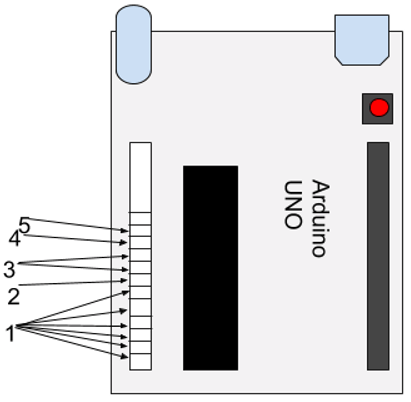This set of Arduino Multiple Choice Questions & Answers (MCQs) focuses on “Board Hardware Specifications”.
1. What is the operating frequency of the Arduino UNO Board?
a) 20 MHz
b) 16 Mhz
c) 6 MHz
d) 10 MHz
View Answer
Explanation: The Arduino UNO makes use of the ATmega328 Processor which has an operating frequency of 16 MHz and a maximum operating frequency of 20 MHz which is not advisable since the higher the switching speed, the hotter the chip will get and may even lead to physical damage of the board.
2. What is the Maximum Operating Voltage of the Arduino Due?
a) 20V
b) 19V
c) 5V
d) 3.3V
View Answer
Explanation: Most of the Arduino Boards like the Arduino Mega and Uno, have an operating voltage of 5V. However, the Arduino Due, which is supported by the SAM3X8E ARM Cortex-M3 CPU supports a maximum of 3.3V.
3. Analog Pins in the Arduino boards work on the principle of PWM. What is the full form of PWM?
a) Pin Wide Modulation
b) Pulse Waveform Modulation
c) Pulse Width Modulation
d) Pulse Wave Modulation
View Answer
Explanation: Since perfect analog waveforms can’t be achieved on a digital circuit, Pulse Width Modulation is used to create pseudo analog waveforms by varying the “ON” and “OFF” time of a pulse continuously hence creating a series of pulses whose “width” can be modified according to the need of the user. Here “width” refers to the “ON” time of the pulse. Hence the name Pulse Width Modulation.
4. How much Program Memory does the Arduino UNO have?
a) 24K bytes
b) 256K bytes
c) 32K bytes
d) 2K bytes
View Answer
Explanation: The Arduino UNO is powered by the ATmega328 Processor which has a flash memory (A type of memory that is retained by the chip even after the power supply to the chip is cut off) of 32K bytes.
5. Which of the following boards from the Arduino Family is not powered by a variant of the ATmega processors?
a) Arduino UNO
b) Arduino Nano
c) Arduino Mega
d) Arduino Due
View Answer
Explanation: The Arduino Due uses the SAM3X8E ARM Cortex-M3 CPU which is a member of the Atmel ARM-Based Processors which uses the RISC (Reduced instruction Set Computing) Architecture and has a maximum operating frequency of 84MHz.
6. What is the full form of EEPROM?
a) Electrically Erasable Programmable Read Only Memory
b) Electrically Encoded Programmable Read Only Memory
c) Electronic Embedded Programmable Read Only Memory
d) Encrypted Electronic Programmable Read Only Memory
View Answer
Explanation: EEPROM is a type of non-volatile memory which can be programmed and erased by voltage pulses as input. It’s used to handle small amounts of data. Originally EEPROMs supported only small amounts of data handling limited to 1 Byte. But however, nowadays EEPROMs can support page operations of many bytes.
7. What is the full form of SRAM?
a) Synchronized Random Access Memory
b) Static Random Access Memory
c) Simplified Random Access Memory
d) Segregated Static Random Access Memory
View Answer
Explanation: SRAM is a type of volatile memory (volatile as in, it retains the data as long as power is being supplied to it), which is used for faster access of data. It uses bistable latching circuitry to store data bit by bit. Here, a latch is also called a flip flop which basically has two states depending upon the input signal and it is in this way it stores each bit of data.
8. The Arduino Diecimila has 14 Digital I/O Pins of which __ pins can provide PWM output.
a) 1
b) 4
c) 6
d) 8
View Answer
Explanation: On the Arduino Diecimila the pins 3, 5, 6, 9, 10, 11 provide 8-bit PWM output. Here PWM refers to Pulse Width Modulation which the Arduino being a digital circuit, uses to replicate analog waveforms for providing traditional voltage specific control.
9. From the diagram below please replace the numeric labels with the pin names.

a) 1-Analog Pins, 2-Vin, 3-GND, 4-5v, 5-3V3
b) 1-Analog Pins, 2-Vin, 3-GND, 4-3v3, 5-5V
c) 1-Analog Pins, 2-Vin, 3-5V, 4-GND, 5-3V3
d) 1-Analog Pins, 2-5V, 3-Vin, 4-GND, 5-3V3
View Answer
Explanation: The arduino Uno contains 6 Analog Pins numbered A0-5, 1 Vin Pin, 2 Ground Pins, 1 5V and 1 3V pin, in that order. These pins take an analog input from an external source and use the onboard ADC (Analog To Digital Convertor) Circuit to map these voltages ranging from 0-5V to a decimal range of 0 to 1023.
10. The Arduino UNO uses the FTDI USB to Serial Driver Chip.
a) True
b) False
View Answer
Explanation: The Arduino UNO uses the ATmega16U2 which is programmed as a USB to Serial Converter. This is used when an inbuilt USB adapter is not present and provides the same functionality as the USB adapter, I.e. transferring programs from the computer to the chip and vital information from the chip back to the computer thus forming an effective 2 way communication.
Sanfoundry Global Education & Learning Series – Arduino.
To practice all areas of Arduino, here is complete set of 1000+ Multiple Choice Questions and Answers.
If you find a mistake in question / option / answer, kindly take a screenshot and email to [email protected]
- Apply for Electrical & Electronics Engineering Internship
- Check Arduino Books
- Check Electrical Engineering Books
- Apply for Electrical Engineering Internship
- Check Electrical & Electronics Engineering Books
